Rosehip Oil for Hair: Pros and Cons

Rosehip oil has become a buzzworthy ingredient in natural hair care, praised for its nourishing and restorative properties.
Rosehip seed oil is packed with vitamins, essential fatty acids, and antioxidants, making it a versatile addition to hair care routines.
But is it the miracle solution for every hair type? In this article, we’ll explore the benefits and drawbacks of using rosehip oil for your hair, helping you decide if it’s the right choice for your needs.
Whether you’re looking to combat dryness, promote hair growth, or treat inflammatory scalp conditions, understanding this powerful oil is key to achieving your hair care goals.
- Is rosehip oil good for hair?
- How to use
- Benefits
- Downsides
- Rosehip oil alternatives
- Treatment against hair loss
Is rosehip oil good for hair?
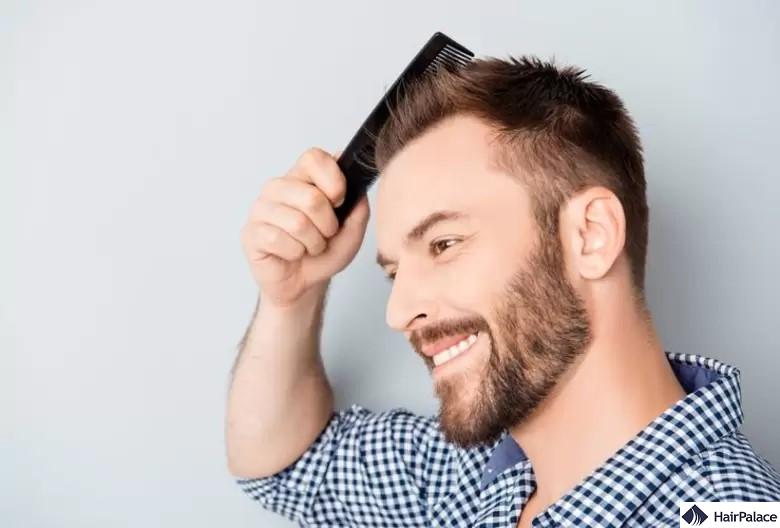
Rosehip oil is highly beneficial for hair, offering a range of nourishing and restorative properties.
Rich in essential fatty acids, vitamins A, C, and E, as well as antioxidants, it helps strengthen hair strands, improve scalp health, and promote a healthy environment for hair growth.
Its hydrating qualities make it particularly effective for combating dryness and reducing frizz, leaving hair smoother and more manageable.
Additionally, rosehip oil can soothe an irritated scalp, thanks to its anti-inflammatory properties, and may assist in addressing issues like dandruff.
Incorporating rosehip oil into your hair care routine can enhance shine, restore vitality, and support overall hair health.
How to use rosehip oil on hair
Using rosehip oil on your hair is simple and can be tailored to your specific needs.
Here’s how you can incorporate it into your routine:
- As a Scalp Treatment
Warm a small amount of rosehip oil (about a teaspoon) in your hands and gently massage it into your scalp using circular motions. This improves blood circulation and ensures the oil penetrates deeply into the hair roots. Wash it out with a mild shampoo. - Rosehip Oil Hair Mask
Mix rosehip oil with nourishing oils like coconut or argan oil for a deep conditioning treatment. Apply the mixture evenly to your hair, focusing on the ends, and leave it on for 30-60 minutes before rinsing with shampoo. - To Tame Frizz and Add Shine
For daily use, apply a few drops of pure rosehip seed oil to the ends of your hair to tame frizz and add shine. Be careful not to use too much, as it may make your hair greasy. - In Your Conditioner
Add a few drops of rosehip oil to your regular conditioner for an extra boost of hydration and nutrients. Apply the conditioner as usual and rinse thoroughly. - As a Pre-Shampoo Treatment
Apply rosehip oil to dry hair before shampooing to protect your hair from losing natural oils during washing. Focus on dry or damaged areas for best results.
By using rosehip oil consistently in one or more of these ways, you can maximize its benefits for healthier, shinier, and more nourished hair.
Rosehip oil benefits for hair
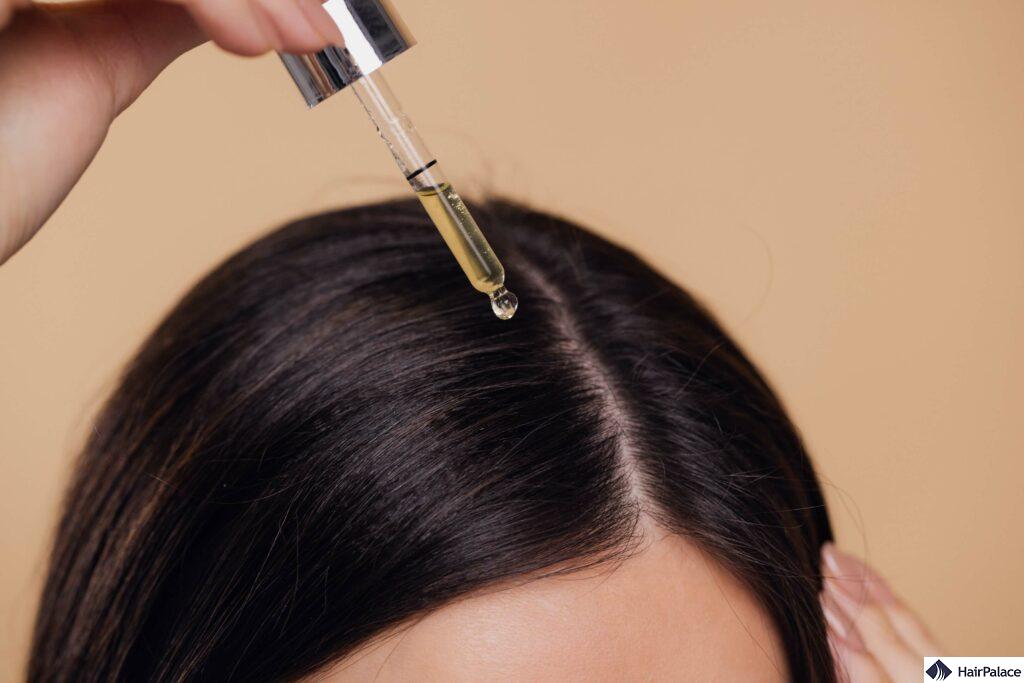
Nourishes and Strengthens Hair
Rosehip oil is rich in essential fatty acids, like omega-3 and omega-6, which deeply nourish the hair shaft, strengthening it from within and reducing hair breakage.
Promotes Scalp Health
Packed with vitamin C, as well as A and E, rosehip oil supports hair health by boosting cell regeneration and combating dryness. A healthy scalp is crucial for strong and vibrant hair growth.
Hydrates and Reduces Frizz
Its hydrating properties help to lock in moisture, making hair smoother and more manageable. This reduces frizz and makes it easier to style.
Adds Shine and Softness
Rosehip oil can enhance the natural shine of your hair, giving it a glossy, healthy appearance while also leaving it soft to the touch.
Soothes Irritated Scalp
With anti-inflammatory and antioxidant properties, rosehip oil can calm sensitive skin, and alleviate conditions like dandruff and itchiness.
Supports Hair Growth
One of the main benefits of rosehip oil for hair is that it improves blood circulation to the scalp which creates an ideal environment for hair follicles to thrive.
Protects Against Damage
Its antioxidants help protect hair from environmental damage, such as UV rays and pollution, which can weaken and dull the hair over time.
Downsides of using Rosehip oil
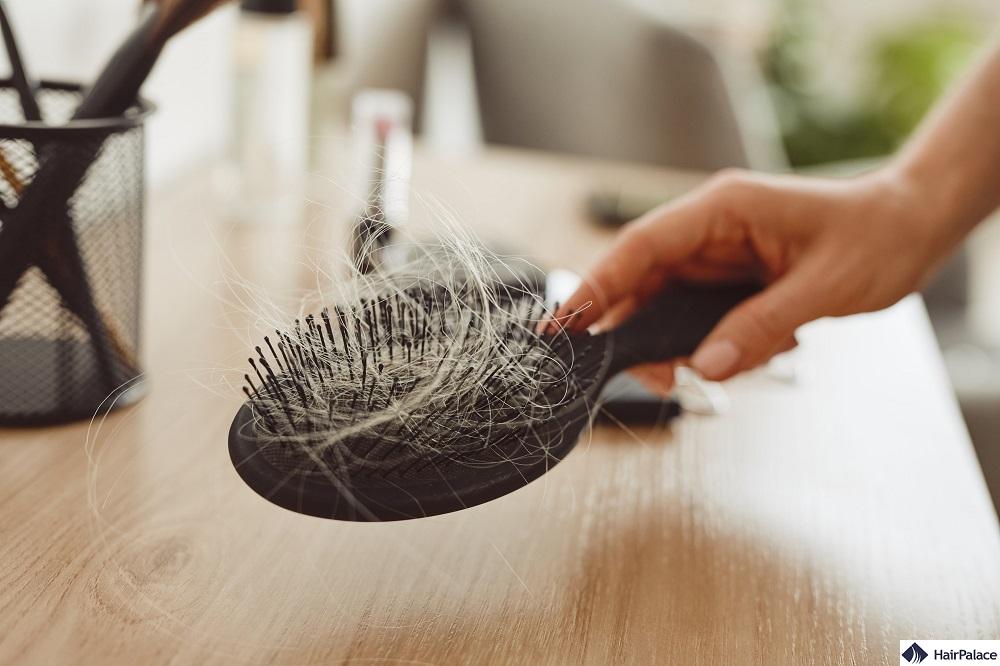
Applying rosehip oil for hair growth offers various benefits, but as with anything, there are also some risks to be aware of.
Allergic Reactions
Some individuals may experience allergic reactions to cold-pressed rosehip oil, including redness, itching, or swelling on the scalp.
It’s essential to perform a patch test before applying it extensively.
Greasy Residue
Rosehip oil can leave a greasy residue if used in excessive amounts, especially for people with fine or oily hair.
This may make the hair appear limp and heavy.
Potential for Clogged Pores
Applying rosehip oil directly to your scalp in large quantities may clog pores, leading to conditions such as folliculitis or acne in those with acne-prone skin.
Limited Shelf Life
Rosehip oil has a relatively short shelf life and can go rancid quickly if not stored properly.
Using rancid oil can cause skin irritation or diminish its effectiveness.
Not a Standalone Solution for Hair Loss
While it supports scalp health and hair growth, rosehip oil is not a miracle cure for significant hair loss or medical conditions like alopecia.
It works best as a complementary treatment.
Using rosehip oil in moderation and considering your hair type and scalp condition can minimize the downsides while enjoying its benefits.
Rosehip oil alternatives
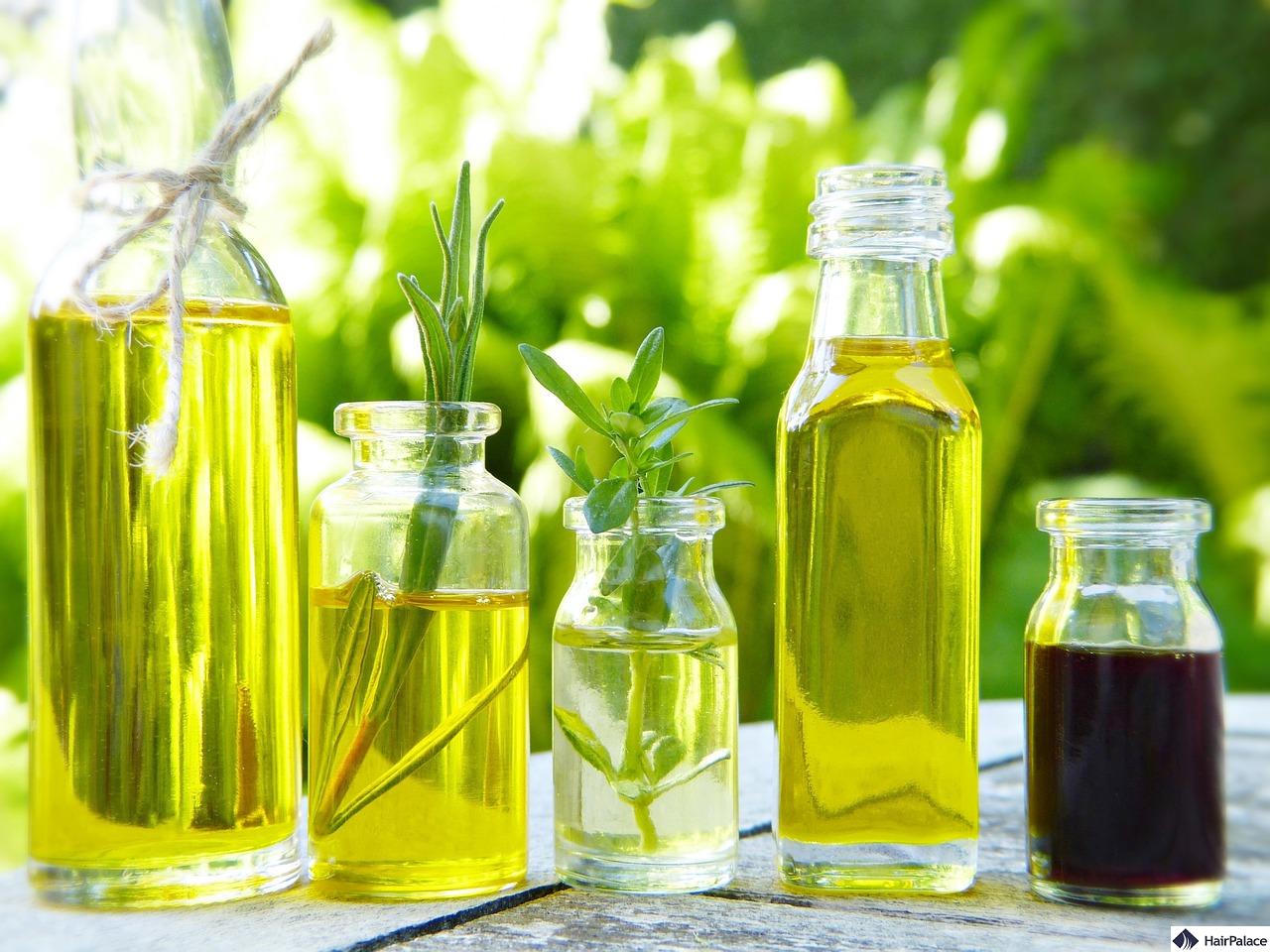
If rosehip oil isn’t your preferred choice, several other essential oil treatments can work effectively for hair loss.
- Castor Oil
Known for its high ricinoleic acid content, castor oil promotes hair growth by improving blood circulation to the scalp and moisturizing dry hair. It’s also antimicrobial, which helps maintain scalp health. - Coconut Oil
Coconut oil penetrates the hair shaft to reduce protein loss, strengthen hair, and promote growth. It’s especially effective for preventing breakage and hydrating dry hair. - Argan Oil
Sometimes called “liquid gold,” argan oil is loaded with antioxidants, vitamin E, and fatty acids, which protect hair from damage and enhance growth. It also adds shine and improves elasticity. - Jojoba Oil
Closely mimicking natural scalp sebum, jojoba oil moisturizes and nourishes hair follicles, creating an optimal environment for growth and preventing dryness or dandruff. - Peppermint Oil
Peppermint oil stimulates blood circulation in the scalp and has been shown to promote hair growth in some studies. It’s best used diluted with a carrier oil to avoid irritation. - Rosemary Oil
Widely recognized for its hair-growth benefits, rosemary oil can stimulate blood flow to the scalp and prevent hair thinning. Studies have compared it to minoxidil for its effectiveness. - Tea Tree Oil
Tea tree oil is ideal for addressing scalp conditions contributing to hair loss, such as dandruff or fungal infections. It helps unclog hair follicles and maintain a healthy scalp. - Almond Oil
Rich in magnesium and biotin, almond oil strengthens hair and reduces shedding. It’s also lightweight, making it suitable for fine hair.
Alternatively, you may try apple cider vinegar, which, though not an essential oil, has shown promise as a treatment for hair loss in some cases.
Treatment against hair loss
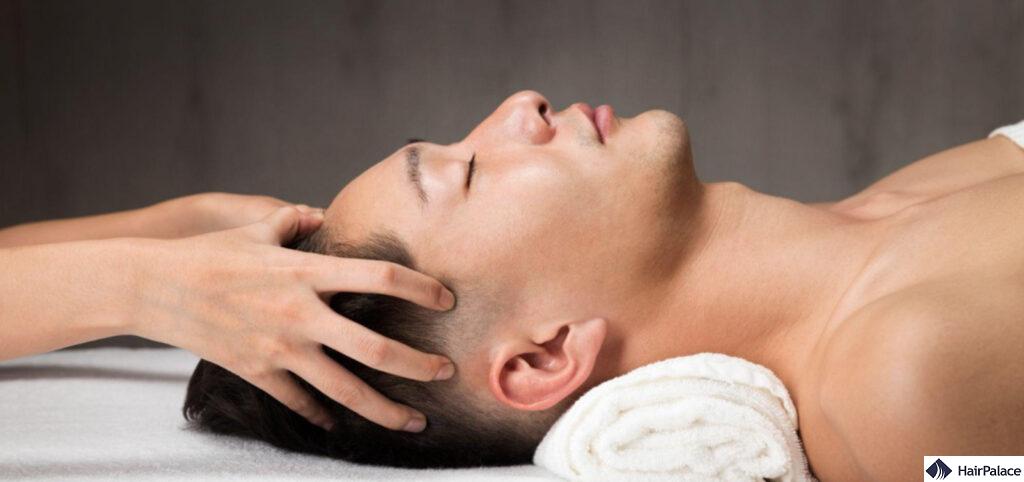
If essential oils for hair loss fail to provide you with the results you’re after, there are many other proven ways of addressing hair loss:
Minoxidil (Rogaine)
An over-the-counter topical treatment approved for hair loss, minoxidil stimulates hair growth by improving blood flow to the hair follicles.
It’s available as a foam or liquid and is suitable for both men and women.
Finasteride (Propecia)
A prescription oral medication for men, finasteride works by inhibiting the hormone dihydrotestosterone (DHT), which causes hair follicle shrinkage.
It’s effective in slowing hair loss and promoting regrowth.
Hair Transplant Surgery
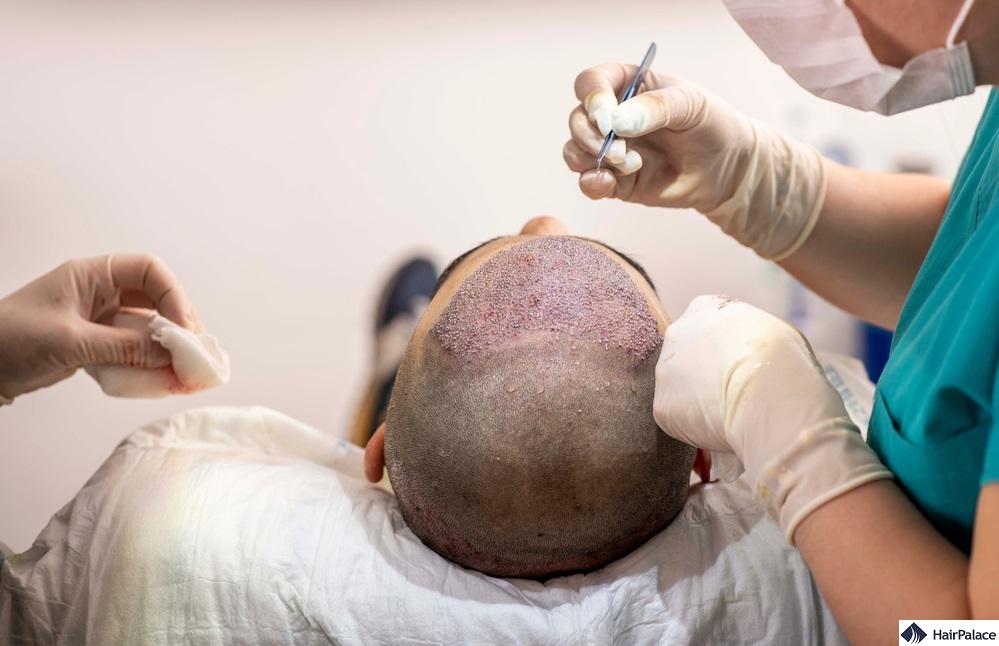
A permanent solution for hair loss, this surgical procedure involves moving hair follicles from a donor area to bald or thinning areas.
Techniques include Follicular Unit Transplantation (FUT) and Follicular Unit Extraction (FUE).
Platelet-Rich Plasma (PRP) Therapy
PRP therapy involves injecting plasma rich in growth factors, derived from the patient’s own blood, into the scalp.
This stimulates hair follicles, promoting growth and reducing hair loss.
Low-Level Laser Therapy (LLLT)
Also known as laser hair therapy, this non-invasive treatment uses light energy to stimulate hair follicles, improve blood flow, and encourage regrowth.
Scalp Micropigmentation (SMP)
A non-surgical cosmetic treatment that uses pigment to create the appearance of a fuller scalp or a closely shaved head.
SMP is ideal for those with advanced hair loss.
Last medically reviewed on December 12th, 2024
- ISHRS: 2020 Practice Census Resultshttps://ishrs.org/wp-content/uploads/2020/05/Report-2020-ISHRS-Practice-Census-05-22-20.pdf
- Vogel James E et al. Hair Restoration Surgery: The State of the Art. Aesthetic Surgery Journal 2013;1:33http://dx.doi.org/10.1177/1090820X12468314
- Kaufman KD et al. Finasteride in the treatment of men with androgenetic alopecia. Journal of the American Academy of Dermatology. 1998;39(4):578-589.https://doi.org/10.1016/S0190-9622(98)70007-6
- Panahi Y, Taghizadeh M, Marzony ET, Sahebkar A. Rosemary oil vs minoxidil 2% for the treatment of androgenetic alopecia: a randomized comparative trial. Skinmed. 2015 Jan-Feb;13(1):15-21. PMID: 25842469.https://pubmed.ncbi.nlm.nih.gov/25842469/
- Suchonwanit P, Thammarucha S, Leerunyakul K. Minoxidil and its use in hair disorders: a review. Drug Des Devel Ther. 2019 Aug 9;13:2777-2786.https://doi.org/10.2147%2FDDDT.S214907
- Olsen EA, Weiner MS, Delong ER, Pinnell SR. Topical minoxidil in early male pattern baldness. Journal of Am Ac Derm. 1985;13(2):185-192https://doi.org/10.1016/S0190-9622(85)70157-0
- Williamson, D., Gonzalez, M. and Finlay, A. (2001), The effect of hair loss on quality of life. Journal of the European Academy of Dermatology and Venereology, 15: 137-139.https://doi.org/10.1046/j.1468-3083.2001.00229.x


